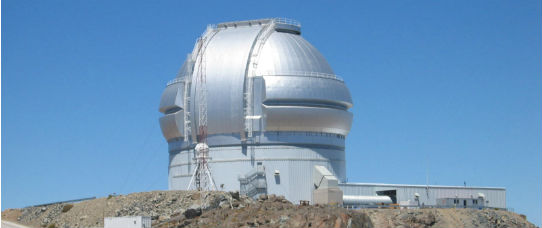Major CFI funding announced to build Gemini a new spectrograph
Major CFI funding announced to build Gemini a new spectrograph

UVic astronomers and engineers will use their adaptive optics expertise to develop and test a key component of this novel instrument.
The annual CFI Innovation Fund awards were announced today, with over $5 million dollars granted to build a spectrograph unlike any in the world. This is big news for astronomers and engineers across Canada, including here in Victoria: a key part of that spectrograph will be developed and tested by members of UVic’s Astronomy Research Centre.
The Gemini InfraRed Multi-Object Spectrograph (GIRMOS) will be used on the 8 meter Gemini South telescope in Chile. By taking detailed pictures of the infrared light emitted by objects in our universe, it will allow astronomers to study how stars and planets form, and to investigate some of the oldest, faintest, and most distant objects in space.
To create clear, sharp pictures, GIRMOS will need an adaptive optics system. These systems compensate for the blurriness caused by Earth’s atmosphere by quickly changing the way light is reflected within an astronomical instrument, based on real-time measurements of the images being received. Astronomers and engineers from the Astronomy Research Centre at the University of Victoria are world-class experts in adaptive optics, having already built and tested the highly successful RAVEN instrument on the Subaru Telescope in 2014-2016.
ARC members who will be involved in the development and testing of GIRMOS’s adaptive optics system include Colin Bradley, a faculty member of the Department of Mechanical Engineering, Dave Andersen & Jean-Pierre Veran, adjunct professors from NRC Herzberg, and Olivier Lardiere, an ARC associate also from NRC Herzberg. As well, Kim Venn and Sara Ellison, faculty members of the Department of Physics and Astronomy, and Luc Simard, adjunct professor from NRC Herzberg, are contributors to the science working group, which identifies and prioritizes the key uses for the spectrograph.
In addition to being an important tool for the Gemini Observatory, GIRMOS also will support other telescopes currently in development. After the James Webb Space Telescope is launched in 2018, GIRMOS will be able to provide important follow-up observations to support its discoveries. And the lessons learned in the design and construction of GIRMOS will lay the groundwork for developing an even better spectrograph for the Thirty Meter Telescope, planned for 2024.
The GIRMOS project is being led by Prof. Suresh Sivanandam, at the University of Toronto’s Dunlap Institute for Astronomy & Astrophysics. In addition to the University of Victoria, other major partners include Dalhousie University, the National Research Council, University of British Columbia, Laval University, and Saint Mary’s University.
Click here for more information on GIRMOS.
